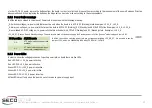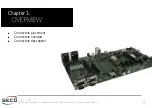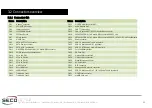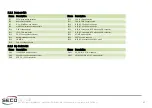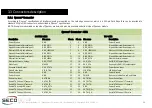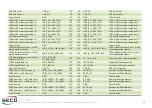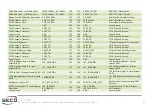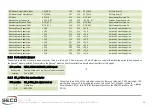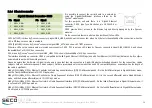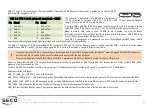
CQ7-A30
CQ7-A30 - Rev. First Edition: 1.0 - Last Edition: 2.0 - Author: S.B. - Reviewed by G.G. Copyright © 2016 SECO S.r.l.
31
Please be aware that USB 3.0 connectivity can be obtained only in case that it is supported by the Qseven
®
module plugged into the MXM connector.
Avoid using USB 3.0 cables if the Qseven
®
module used doesn
’
t offer such an interface.
Please also remember that USB SuperSpeed interface is available on CN33 only when SW6 switch #2 is set on ON position.
USB 3.0 port #1, which could offer OTG functionalities (it depends on the Qseven
®
module used), is available on a single USB 3.0
type micro-AB receptacle, CN33.
This connector is a standard micro-AB USB 3.0 receptacle; it
can be connected to all types of USB 1.1 / USB 2.0 / USB 3.0 devices using standard
micro-A or micro-B USB 3.0 or USB 2.0 plugs..
A micro-A USB cable has to be used when the system has to work in Host mode. In this
case, USB_VBUS is a power output of CQ7-A30 Carrier Board for the connected device.
When a micro-B USB cable is used, its USB_ID pin is floating; this way, the board
acknowledges that it must configure itself to work as a Client. In this case, USB_VBUS is an
input of the carrier board from the external Host.
For USB 3.0 connections it is mandatory the use of SuperSpeed certified cables, whose
SuperSpeed differential pairs are individually shielded inside the global cable
’
s external shielding.
The USB 2.0 Host port #1 is always available on the connector CN33 only. In case the Qseven
®
module used doesn
’
t offer USB 3.0 port #1, it will be always
possible to use USB 2.0 port #1, simply by plugging an USB 2.0 micro-A (Host mode) or micro-B (Client mode) cable.
Please be aware that the USB OTG port has been designed according to, published by SGET consortium, that foresee the use of signal USB_DRIVE_VBUS,
present on formerly reserved pin #56.
Correct USB OTG functionalities, therefore, are ensured only for modules developed according to Qseven
®
Specifications rel. 2.0 Errata Sheet.
Signal description of this port:
/USB_P1-: USB OTG Port #1 differential pair.
USB_SSTX1-/US: USB Superspeed port#1 transmitting differential pair, switched to the micro-AB connector CN33 using the dedicated switch SW6.
USB_SSRX1-/US: USB Superspeed port#1 receiving differential pair, switched to the micro-AB connector CN33 using the dedicated switch SW6.
USB_VBUS: USB voltage rail. It is an input for USB port working in Client mode, an output for Host mode.
USB_ID: Client/Host identification signal. This signal is high when the USB port works in client mode, is low when works in Host mode.
USB 3.0 OTG Port #1 micro-AB receptacle - CN33
Pin Signal
Pin Signal
1
USB_VBUS
6
USB_SSTX1-
2
USB_P1-
7
US
3
8
GND
4
USB_ID
9
USB_SSRX1-
5
GND
10
US

